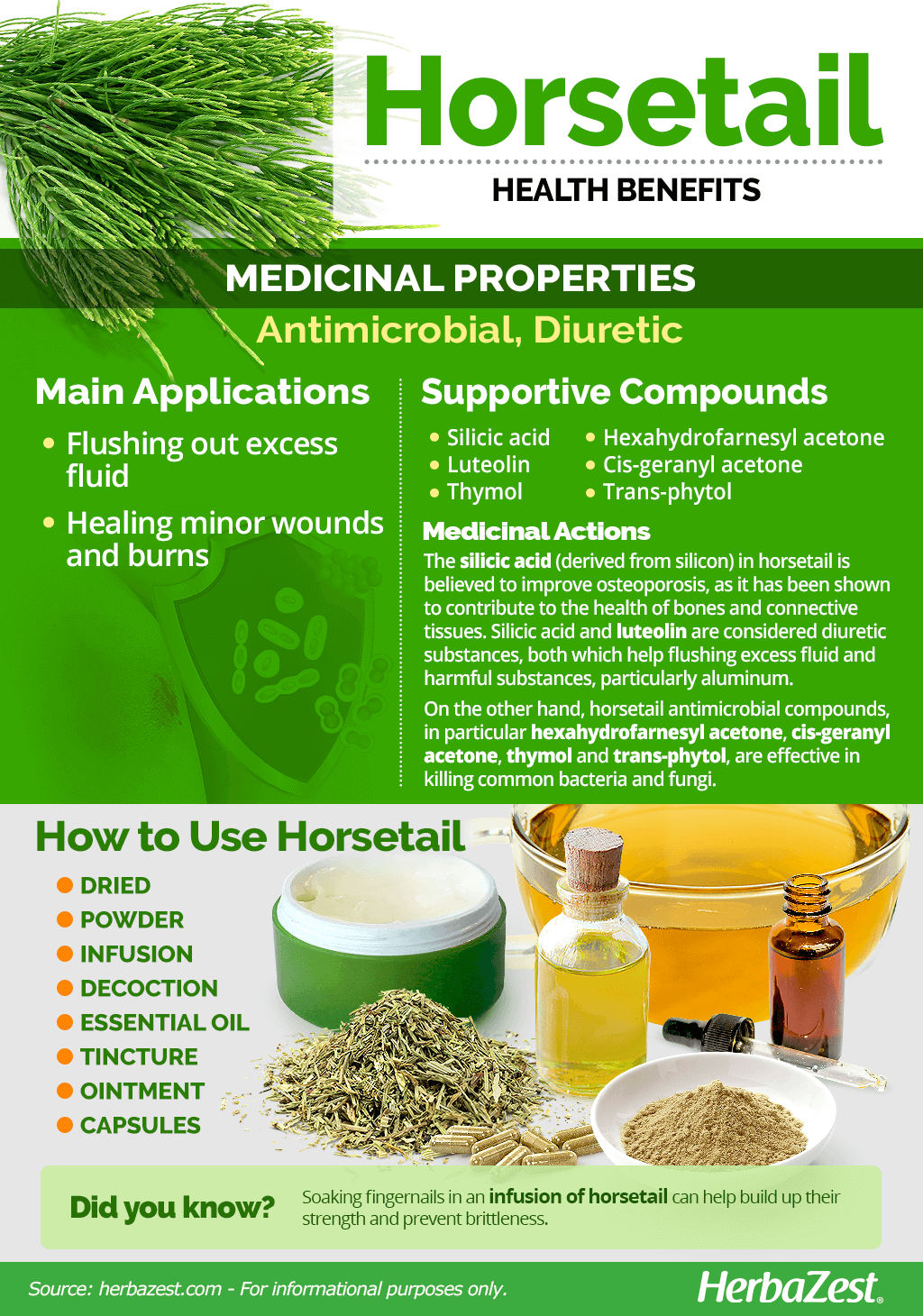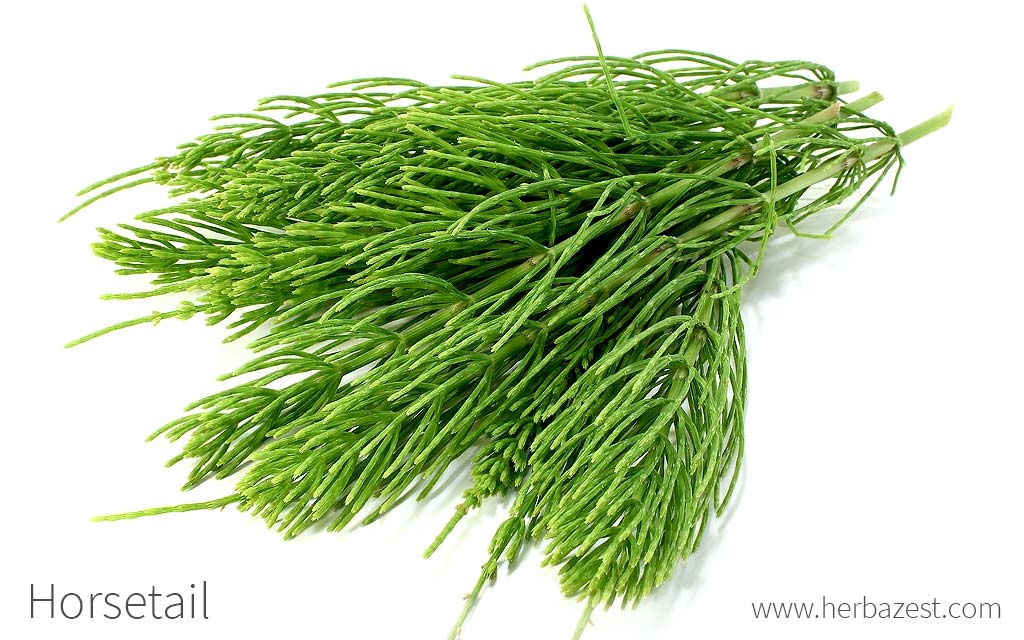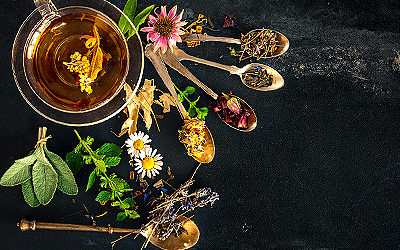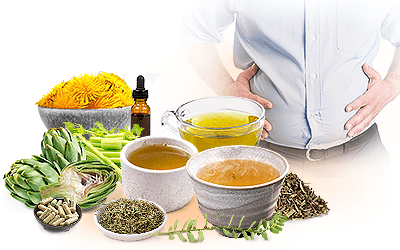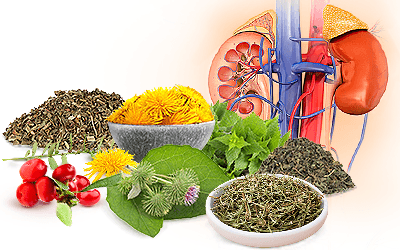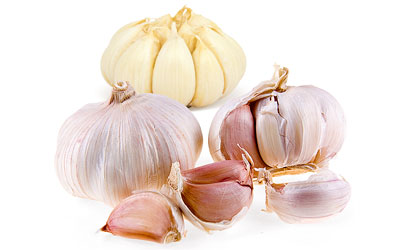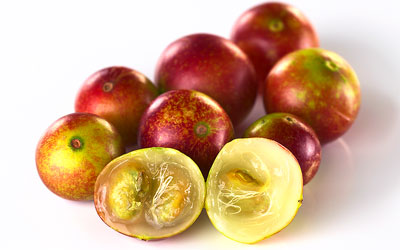Horsetail is known as a living fossil - a relic of prehistoric times, which belongs to the only surviving genus in its family of mostly extinct plants. Much of its popularity today can be traced back to the Roman Empire, where it was widely used as a remedy. This hardy plant still grows across much of the world, providing several health benefits.
Horsetail Medicinal Properties
- Medicinal action Antimicrobial, Diuretic
- Key constituents Silicic acid, luteolin, hexahydrofarnesyl acetone, cis-geranyl acetone, thymol, trans-phytol
- Ways to use Capsules, Decoctions, Hot infusions/tisanes, Tincture, Powder, Ointment, Essential oil
- Medicinal rating (1) Very minor uses
- Safety ranking Use with caution
Health Benefits of Horsetail
Horsetail has not been the subject of extensive research, but preliminary studies suggest that horsetail is beneficial for:
Flushing out excess fluid. Horsetail has been shown to have diuretic properties.
Healing minor wounds and burns. Applied topically, horsetail has been used to promote healing of small injuries.
Additionally, horsetail is thought to have the ability to strengthen bones and nails. As such, it may also be recommended for ameliorating the effects of osteoporosis, although no conclusive studies have been performed to determine the extent of horsetail's effect on bones.
How It Works
The horsetail plant contains high levels of silicic acid and luteolin, both of which are thought to be diuretic substances that contribute to horsetail's ability to rid the body of unnecessary fluid. Silicic acid can also help the kidneys to rid themselves of other harmful substances, particularly aluminum.
Horsetail is popularly used to heal small wounds because of its high concentrations of antimicrobial compounds, notably hexahydrofarnesyl acetone, cis-geranyl acetone, thymol, and trans-phytol, all of which are effective in killing common bacteria and fungi.
A particular characteristic of horsetail is its silicon content, mainly present as silicic acid. While silicon (Si) is the second most abundant element on Earth after oxygen, and the mineral base for most plant life, it is not considered as an essential nutrient, except for members of the prehistoric Equisetaceae family, including horsetail. It is thought that the silicon in horsetail improves osteoporosis as it has been shown to support the health of bone and connective tissues.
Other herbs with antimicrobial properties are calendula and echinacea, whereas artichoke and asparagus produce a diuretic effect, helping remove waste materials through the urine.
Horsetail Side Effects
Horsetail is not known to have many common side effects, but some participants in studies reported headaches caused by taking supplemental forms. Overconsumption may cause potassium deficiency (hypokalemia), which causes symptoms such as weakness, muscle or abdominal cramping, numbness, nausea, constipation, palpitations, or fainting.
Horsetail has also been shown to cause a vitamin B1 (thiamin) deficiency. Symptoms include headache, nausea, fatigue, irritability, depression, and abdominal discomfort.
Horsetail Cautions
Horsetail should not be used for an extended period of time. If it is being used topically, it should not be applied to large or open wounds. Care must also be taken to ensure that the proper species of horsetail, Equisetum arvense, is used. A related species called Equisetum palustre is known for being toxic to horses and other livestock, and humans are advised to avoid consumption for their safety.
Horsetail contains nicotine, which is harmful for children as well as pregnant and breastfeeding women as it can cause damage to the fetus and babies.
People with diabetes, heart disease, kidney disease, and gout should not consume horsetail.
There are also several known medical interactions that can occur when horsetail is taken with other drugs. This herb should not be consumed with:
Alcohol. Both alcohol and horsetail reduce thiamine in the body, and using the two together could cause seriously low levels of the vitamin.
Nicotine. Horsetail contains nicotine, and consuming it with other sources of nicotine could cause an excess of the drug in the body.
Digoxin. Potassium deficiency, which is a potential side effect of horsetail consumption, is especially hazardous while taking this drug.
Diuretics. Combining two diuretics may cause dehydration or worsen kidney problems.
Lithium. Consuming horsetail while taking lithium may cause a dangerous buildup of lithium in the body.
Consulting a physician is always recommended prior to beginning an herbal regimen.
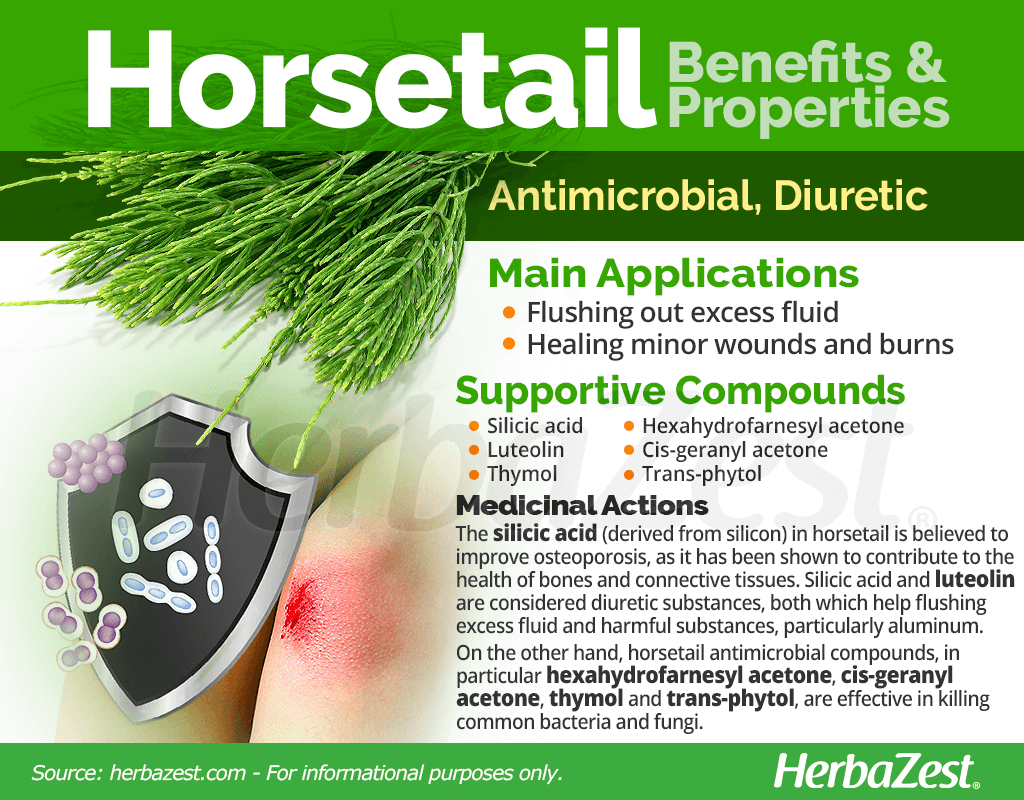
How to Consume Horsetail
- Edible parts Stem
Horsetail's health benefits are most effectively obtained through medicinal forms, so the most commonly found preparations of the plant are remedies.
The fertile, spore-sprouting stems of the horsetail plant are edible, and the ancient Romans enjoyed them in salads. However, these stems are not the ones commonly used in medicinal preparations, and it is not known whether they provide the same benefits.
Natural Forms
- Dried. The dried stalks of horstail are used to prepare infusions and many other herbal remedies that extract their antimicrobial and diuretic properties.
- Powder. Powdered horsetail stems can be added to other foods or drinks for a simple way to reap the health benefits of the herb.
Infusion. Horsetail tea is one of the most effective and simple preparations for ridding the body of excess fluids. It can also aid the strengthening of bones and connective tissue.
Decoction. Soaking fingernails in an infusion of dried leaves can help build up their strength and prevent brittleness. Small injuries may also be soaked in an infusion to prevent infection.
Herbal Remedies & Supplements
Tincture. Instead of tea, a horsetail tincture may be added to a drink to provide the same benefits but with a less intense taste. Additionally, it can be added to lotions or ointments and used on small wounds and scratches to prevent microbial growth.
Ointment. Horsetail ointment also protects minor wounds, promotes healing in the area, and even reduces pain. It can be applied directly to the skin without any dilution necessary.
Essential oil. The essential oil distilled from the horsetail plant can be added to lotions or diluted in a bath to treat minor cuts and burns. It should not be ingested.
Capsules. Horsetail capsules are the most efficient way to consume the herb, and they provide both the diuretic and bone-strengthening properties of horsetail when ingested.
Horsetail remedies are made from the later-sprouting, sterile stems of the horsetail plant.
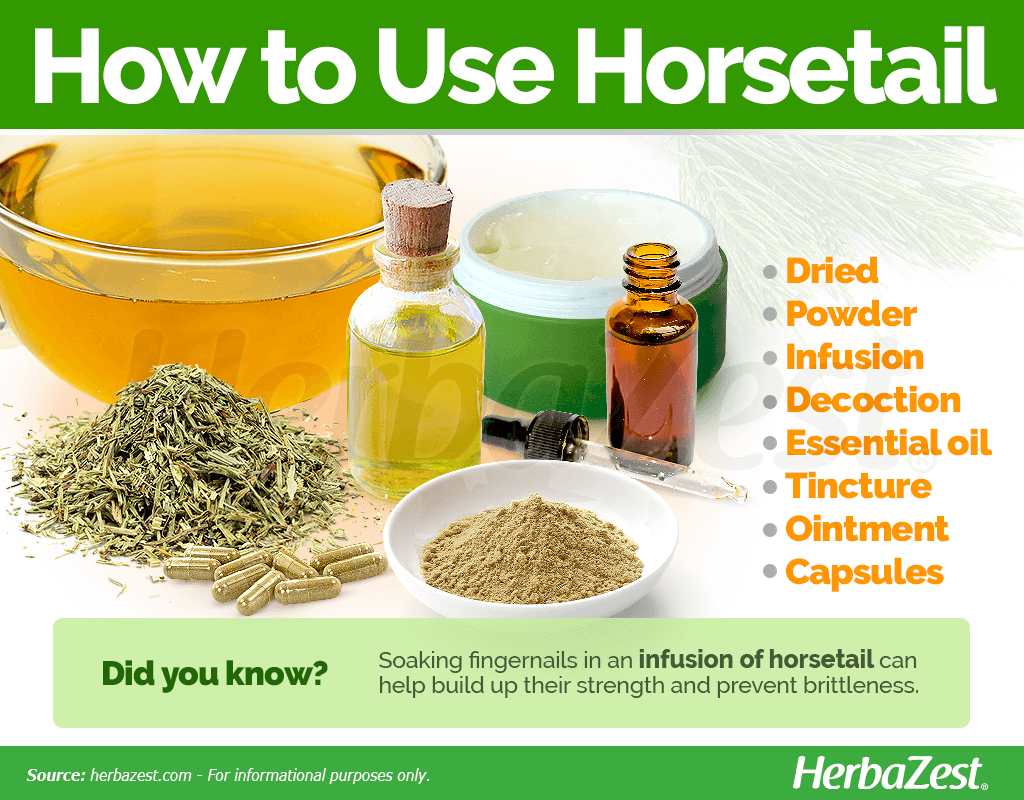
Growing
- Life cycle Perennial
- Harvested parts Stem
- Light requirements Partial shade, Full shade
- Soil Light (sandy), Clay loam
- Growing habitat Everywhere except tundra
- Planting time Spring, Summer, Fall
- Propagation techniques Cuttings
- Potential insect pests Leafhoppers, Flea beetles
Because of its tenacity and ability to thrive in poor conditions, horsetail is an easy plant to grow in any garden or backyard. However, these same qualities make the herb difficult to remove from an area once it has taken root, and it spreads rapidly. Thus, the decision to plant it should be carefully considered, as it will likely remain in the area for years. Alternatively, it can be grown in a large pot to prevent it from taking over a section of land.
Horsetail plants can range in height from 4 - 24 inches (10 - 60 cm). Its natural habitat is damp, sandy soil with plenty of shade, but it can survive nearly anywhere as long as it receives enough water.
It has no seeds; instead, it reproduces through spores, which it grows early in the spring. It is generally propagated by cuttings.
Horsetail also grows root-like rhizomes deep under the soil - up to three feet (1 m) down - and each rhizome can sprout new stems where they reach the surface.
Horsetail should be harvested in early summer by cutting the stem several inches above the ground, ensuring that it can grow back.
Leafhoppers, horsetail flea beetles, and weevils are the pests most likely to damage a horsetail plant.
Other animals also feed on it, including geese, bears, moose, and muskrats. Livestock, such as cows and horses, have been known to eat horsetail as well, but it is toxic to these animals and should not be added to their food or grown where they may encounter it.
Additional Information
- Other uses Cosmetics, Cleaning
Plant Biology
Horsetail is a sparse perennial plant that reproduces by spore and is identifiable by its hollow, jointed stems. It has an extensive network of rhizomes below the soil surface, and it sprouts above ground twice a year in rotations of two different types of stems. Fertile stems appear in early spring and are white to light brown. They grow 6 - 12 inches (15 - 30 cm) tall and are topped by the conical part of the plant that produces its spores. These stems are very short-lived, and once they are gone, the sterile shoots appear. These stems have small branches that are four to six inches (10 - 15 cm) long and grow in whorls of 20. They produce no spores, and last until the first frost.
Horsetail was named for its appearance, which can be likened to a horse's tail, and its genus name - Equisetum - comes from the Latin words equus, meaning horse, and seta, meaning bristle. Several different colloquial names have become associated with E. arvense, including field horsetail, horse pipes, mare's tail, snake grass, scouring rush, bottlebrush, jointed rush, and shave brush.
- Classification
Horsetail belongs to Equisetaceae, or the horsetail family, whose only surviving genus is Equisetum. Plants in this family are considered similar to ferns, but are not closely related to them; all of horsetail's closer relations have gone extinct.
- Related Species
E. arvense, or common horsetail, is not only the most common species of horsetail; it is also the species most often used in remedies because it provides the most health benefits and is safest for consumption. There are 15 other species of horsetail that still exist, but none of these should be consumed. Some of the more notable of the currently extant species are E. giganteum, which can reach heights of 30 feet (9 m), and E. fluvatile, or water horsetail, which grows best in shallow standing water.
Historical Information
Horsetail is the last living member of a family that used to be Earth's dominant plant group. Around 250 million years ago, horsetail and related species in other genera covered the surface of the earth, reaching heights of 50 - 100 feet (15 - 30 m). Since then, all the other genera have gone extinct, but horsetail survived. During the Roman Empire, horsetail was valued for its many medicinal properties, but by the 17th century, American settlers used it mostly for manufacturing yellow dye and scrubbing pots, which gave it the name scouring rush.
Economic Data
The use of horsetail is limited to herbal medicine and the fabrication of personal care products, so its cultivation is limited and has little economical importance. It is mainly grown in gardens for home medicinal uses or as an ingredient for medicinal preparations and supplements.
Popular Beliefs
Because horsetail has a long history of medicinal use, it also has some historical associations with witchcraft, since healing with herbs was thought to be a talent of witches. Additionally, in Ireland, people believed that picking horsetail made them susceptible to kidnapping by fairies. They would say a prayer while gathering the herb to keep the fairies away.
Other Uses
Cosmetics. Horsetail is best known for its medicinal applications, but it is also often added to skin- and haircare products, such as sun tanning, cleansing, and aftershave lotions, as well as to bath products and fragrances.
Household use. Although it is no longer widely used to clean dishes, some people still find horsetail ash combined with water to be an especially effective silver polish.
Horsetail is a hardy and tenacious plant that can grow in some of the worst environments, making it a low-maintenance addition to any garden. Its many health benefits, especially diuretic and antimicrobial properties, make it worthwhile addition to any herbal cabinet.
Sources
- Annals of Clinical and Laboratory Science, The Role of Silicic Acid in the Renal Excretion of Aluminium, 1996
- Georgian Medical News, Phytochemical investigation of Juniper rufescens leaves and fruits, 2009
- Iowa State University, Weed Science, Equisetum: Biology and Management
- Iran Red Crescent Medical Journal, The Effect of Equisetum Arvense (Horse Tail) Ointment on Wound Healing and Pain Intensity After Episiotomy: A Randomized Placebo-Controlled Trial, 2015
- Let's Get Natural With Herbs, pp. 234 - 235
- Penn State University, Weed of the Month: Field Horsetail (Equisetum arvense)
- The Book of Field and Roadside, pp. 167 - 170
- The Journal of the Kilkenny and South-East of Ireland Archaeological Society, Irish Medical Superstition, 1865
- University of California, Davis, Weed Control in Natural Areas in the Western United States
- University of Minnesota, Extension, Horsetail
- Wildflowers and Other Plants of Iowa Wetlands, pp. 247, 265, 267
- Wisconsin Public Television, Growing Horsetail: The Pros and Cons
- Backyard Medicine, pp. 81 - 83
- Phytotherapy Research, Composition and Antimicrobial Activity of Equisetum arvense L. Essential Oil, 2006
- University of Maryland Medical Center, Horsetail
- Evidence-based Complementary and Alternative Medicine, Randomized, Double-Blind Clinical Trial to Assess the Acute Diuretic Effect of Equisetum arvense (Field Horsetail) in Healthy Volunteers, 2014
